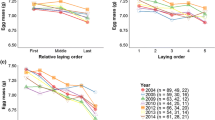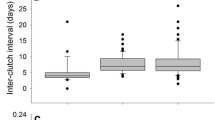Abstract
Environmental uncertainty can be both a cause and consequence of chance variation in many of the phenotypic factors associated with the control of clutch size in birds. When such uncertainty inflates or otherwise influences the variance associated with expected reproductive success for any genotype, it will also influence the resulting phenotypic optima. Random variation that affects the evolution of clutch size optima explicitly may occur both within (intra-) and across (inter-) generations. Examples of intra-generational uncertainty could include chance variation in: (1) the quality and quantity of offspring, (2) parental quality, and (3) temporal resources like food. Inter-generational uncertainty would include chance variation in demographic and population characters. With respect to clutch (or litter) size, almost all forms of uncertainty tend to favor an optimum (genetic) strategy with a clutch that is smaller than the clutch associated with the apparent or actual maximal fitness of an individual parent. The overall effect of all the components of uncertainty can be evaluated through the integration of all this phenotypic variation: however each step of the integration is a conditional expectation of each component. Therefore, a single factor analysis may indicate a false optimum, and an integrated analysis of all components is necessary to evaluate the importance of their individual and joint effects on the adaptive evolution of clutch size.
Similar content being viewed by others
Literature
Alerstam, T. and G. Högstedt. 1984. How important is clutch size dependent adult mortality?Oikos 43, 254–254.
Alexander, R. M.Optima for Animals. London: Edward Arnold.
Boyce, M. S. and C. M. Perrins. 1987. Optimizing Great Tit clutch size in a fluctuating environment.Ecology 68, 142–153.
Brady, R. H. 1979. Natural selection and the criteria by which a theory is judged.Syst. Zool. 28, 600–621.
Brockelman, W. Y. 1975. Competition, the fitness of offspring, and optimal clutch size.Am. Nat. 109, 677–699.
Bulmer, M. G. 1985. Selection for iteroparity in a variable environment.Am. Nat. 126, 63–71.
Charnov, E. L. and J. R. Krebs. 1974. On clutch size and fitness.116, 217–219.
Cody, M. L. 1966. A general theory of clutch sizeEvolution 20, 174–184.
Cohen, D. 1966. Optimizing reproduction in a randomly varying environment.J. theor. Biol. 12, 119–129.
Cooper, W. S. 1984. Expected time to extinction and the concept of fundamental fitness.J. theor. Biol. 107, 603–629.
Cooper, W. S. and R. H. Kaplan. 1982. Adaptive “coin-flipping”: a decision-theoretic examination of natural selection for random individual variation.J. theor. Biol. 94, 135–151.
Crossner, K. A. 1977. Natural selection and clutch size in the European Starling.Ecology 58, 885–892.
Fisher, R. A. 1930.The Genetical Theory of Natural Selection. Oxford, U.K.: Oxford University Press. (Reprint: 1958. New York: Dover).
Gustafsson, L. and W. J. Sutherland. 1988. The cost of reproduction in the collared flycatcherFicedula albicollis.Nature 335, 813–815.
Haldane, J. B. S. and S. D. Jayakar. 1963. Polymorphism due to selection of varying direction.J. Genet. 58, 237–242.
Högstedt, G. 1980. Evolution of clutch size in birds: adaptive variation in relation to territory quality.Science 210, 1148–1150.
Högstedt, G. 1981. Should there be a positive or a negative correlation between survival of adults in a bird population and their clutch size?Am. Nat. 118, 568–571.
Klomp, H. 1970. The determination of clutch size in birds. A review.Ardea 58, 1–124.
Krebs, J. R., J. C. Ryan and E. L. Charnov. 1974. Hunting by expectation or optimal foraging? A study of patch use by chickadees.Anim. Behav. 22, 953–964.
Lack, D. 1947. The significance of clutch size.89, 309–352.
Lack, D. 1954.The Natural Regulation of Animal Numbers. Oxford, U.K.: Oxford University Press.
Lack, D. 1966.Population Studies of Birds. Oxford, U.K.: Clarendon Press.
Levins, R. 1968.Evolution in changing environments. Princeton, NJ: Princeton University Press.
Lewontin, R. C. and D. Cohen. 1969. On population growth in a randomly varying environment.Proc. natn Acad. Sci. U.S.A. 62, 1056–1060.
Loman, J. 1980. Brood size optimization and adaptation among hooded crows (Corvus corone).122, 494–500.
Mangel, M. and C. W. Clark. 1988.Dynamic Modeling in Behavioral Ecology. Princeton, NJ: Princeton University Press.
Martin, T. E. 1987. Food as a limit on breeding birds: a life-history perspective.Ann. Rev. Ecol. Syst. 18, 453–487.
Maynard Smith, J. 1978. Optimization theory in evolution.Ann. Rev. Ecol. Syst. 9, 31–56.
Maynard Smith, J. 1989.Evolutionary Genetics. Oxford, U.K.: Oxford University Press.
Mayo, O. 1983.Natural Selection and Its Constraints. London: Academic Press.
Milkman, R. 1978. Selection differentials and selection coefficients.Genetics 88, 391–403.
Mountford, M. D. 1968. The significance of litter-size.J. Anim. Ecol. 37, 363–367.
Murphy, E. C. and E. Haukioja. 1986. Clutch size in nidicolous birds. InCurrent Ornithology, Vol. 4, R. F. Johnston (Ed.) pp. 141–180. New York: Plenum.
Murray Jr, B. G. 1979.Population Dynamics. New York: Academic Press.
Murray Jr, B. G. 1985. Evolution of clutch size in tropical species of birds. InNeotropical Ornithology, P. A. Buckley, M. S. Foster, E. S. Morton, R. S. Ridgely and F. G. Buckley (Eds), pp. 505–519. Lawrence, KS: Allen Press.
Murray Jr B. G. and V. Nolan, Jr. 1989. The evolution of clutch size. I. An equation for calculating clutch size.Evolution 43, 1699–1705.
Murray Jr, B. G., J. W. Fitzpatrick and G. E. Woolfenden. 1989. The evolution of clutch size. II. A test of the Murray-Nolan equation.Evolution 43, 1706–1711.
Nur, N. 1984. The consequences of brood size for breeding blue tits. II. Nestling weight, offspring survival and optimal brood size.J. Anim. Ecol. 53, 497–517.
Nur, N. 1988a. The consequences of brood size in breeding blue tits. III. Measuring the cost of reproduction: survival, future fecundity, and differential dispersal.Evolution 42, 351–362.
Nur, N. 1988b. The cost of reproduction in birds: an examination of the evidence.Ardea 76, 155–168.
O'Connor, R. J. 1978. Brood reduction in birds: selection for fratricide, infanticide and suicide?Anim. Behav. 26, 79–96.
Perrins, C. M. 1965. Population fluctuations and clutch size in the Great Tij,Parus major L.J. Anim. Ecol. 34, 601–647.
Perrins, C. M. and P. J. Jones. 1974. The inheritance of clutch size in the Great Tit (Parus major L.).Condor 76, 225–229.
Perrins, C. M. and D. Moss. 1975. Reproductive rates in the great tit.J. Anim. Ecol. 44, 659–706.
Pettifor, R. A., C. M. Perrins and R. H. McCleery. 1988. Individual optimization of clutch size in great tits.Nature 336, 160–162.
Price, T. and L. Liou. 1989. Selection on clutch size in birds.Am. Nat. 134, 950–959.
Price, T., M. Kirkpatrick and S. J. Arnold. 1988. Directional selection and the evolution of breeding data in birds.Science 240, 798–799.
Real, L. 1980. Fitness, uncertainty, and the role of diversification in evolution and behavior.Am. Nat. 115, 623–638.
Real, L. and T. Caraco. 1986. Risk and foraging in stochastic environments.Ann. Rev. Ecol. Syst. 17, 371–390.
Rockwell, R. F., C. S. Findlay and F. Cooke. 1987. Is there an optimal clutch size in snow geese?Am. Nat. 130, 839–863.
Royama, T. 1966. Factors governing feeding rate, food requirement and brood size of nestling Great TitsParus major.108, 313–347.
Saiah, H. and N. Perrin. 1990. Autumnal vs spring hatching in the fairy shrimpSiphonophanes grubii (Dybowski) (Crustacea, Anostraca): diversified bet-hedging strategy?Func. Ecol. 4, 769–775.
Schaffer, W. 1974. Optimal reproductive effort in fluctuating environments.Am. Nat. 108, 783–790.
Schifferli, L. 1978. Experimental modification of brood size among House SparrowsPasser domesticus.120, 365–369.
Shields, W. M. 1982.Philopatry, Inbreeding, and the Evolution of Sex. Albany, NY: State University of New York Press.
Shields, W. M. and J. R. Crook. 1987. Barn Swallow coloniality: a net cost for group breeding in the Adirondacks?Ecology 68, 1373–1386.
Slagsvold, T. and J. T. Lifjeld. 1988. Ultimate adjustment of clutch size to parental feeding capacity in a passerine brid.Ecology 69, 1918–1922.
Smith, J. N. M. 1981. Does high fecundity reduce survival in song sparrows?Evolution 35, 1142–1148.
Smith, C. C. and S. D. Fretwell. 1974. The optimal balance between size and number of offspring.Am. Nat. 108, 499–506.
Stearns, S. C. 1976. Life history tactics: a review of the ideas.Quart. Rev. Biol. 51, 3–47.
Stephens, D. W. 1989. Variance and the value of information.Am. Nat. 134, 128–140.
Stephens, D. W. and J. R. Krebs. 1986.Foraging Theory. Princeton, NJ: Princeton University Press.
Tuljapurkar, S. D. 1989. An uncertain life: demography in random environments.Theory. Pop. Biol. 35, 227–294.
Van Noordwijk, A. J., J. H. Van Balen and W. Scharloo. 1981. Heritability of ecologically important traits in the Great Tit. InThe Integrated Study of Bird Populations, H. Klomp and J. W. Woldendorp (Eds), pp. 193–203. Amsterdam: North-Holland.
Williams, G. C. 1966. Natural selection, the cost of reproduction, and a refinement of Lack's principle.Am. Nat. 100, 687–690.
Winkler, D. W. 1985. Factors determining a clutch size reduction in California Gulls (Larus Californicus): A multi-hypothesis approach.Evolution 39, 667–677.
Winkler, D. W. and K. Wallin. 1987. Offspring size and number: a life history model linking effort per offspring and total effort.Am. Nat. 129, 708–720.
Wright, S. 1978.Evolution and the Genetics of Populations. Vol. 4.Variability Within and Among Natural Populations. Chicago, U.S.A.: University of Chicago Press.
Yoshimura, J. 1989. The effects of uncertainty on biological systems: a probabilistic perspective. Ph. D. Thesis, SUNY-ESF, Syraeuse, NY.
Yoshimura, J. and C. W. Clark. 1991. Individual adaptations in stochastic environments.Evol. Ecol. 5, 173–192.
Yoshimura, J. and W. M. Shields. 1987. Probabilistic optimization of phenotype distributions: a general solution for the effects of uncertainty on natural selection?Evol. Ecol. 1, 125–138.
Author information
Authors and Affiliations
Rights and permissions
About this article
Cite this article
Yoshimura, J., Shields, W.M. Components of uncertainty in clutch-size optimization. Bltn Mathcal Biology 54, 445–464 (1992). https://doi.org/10.1007/BF02464843
Received:
Revised:
Issue Date:
DOI: https://doi.org/10.1007/BF02464843




